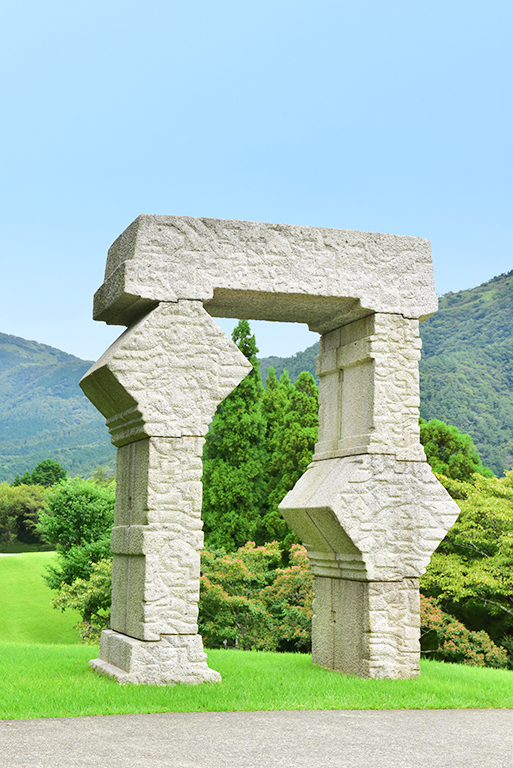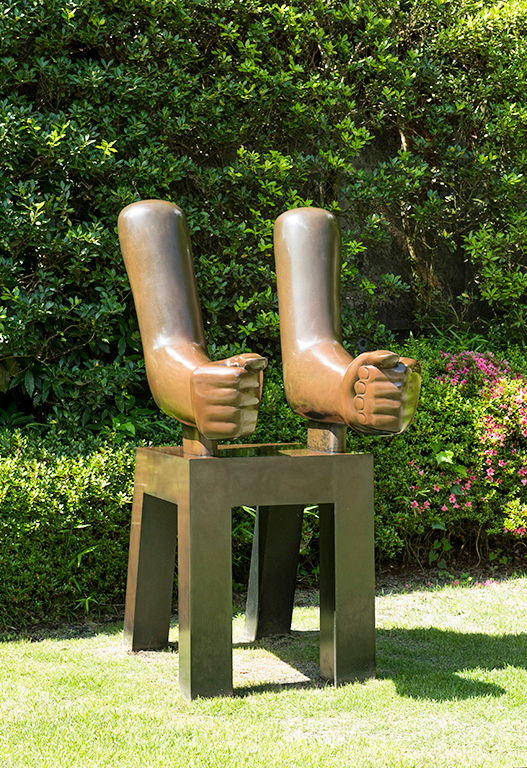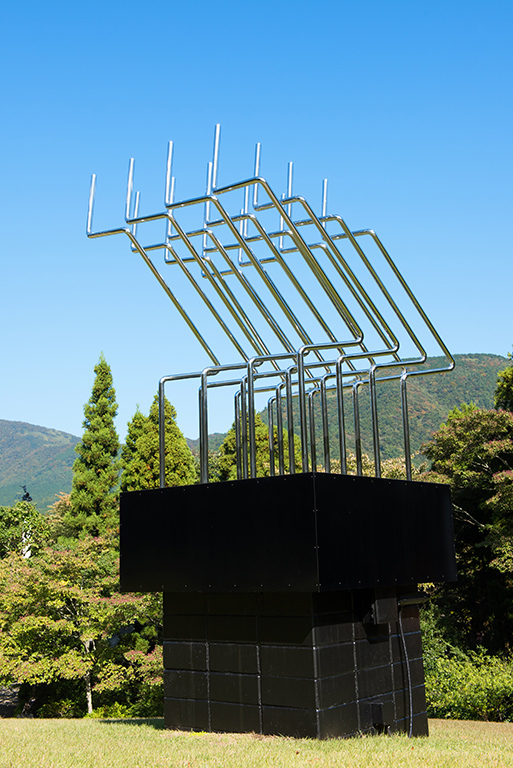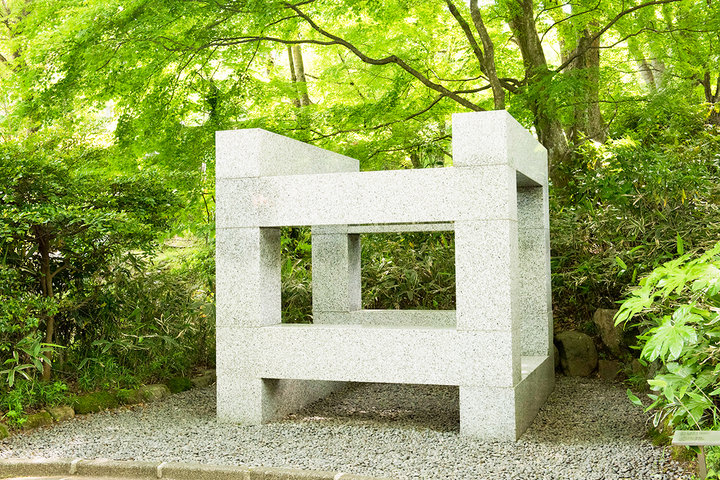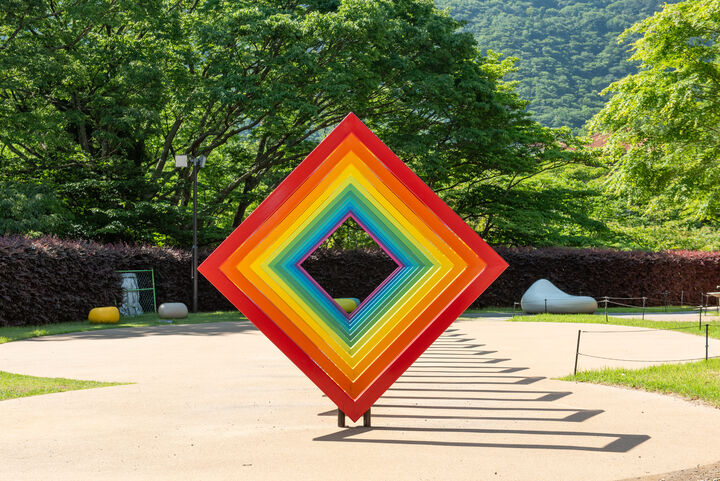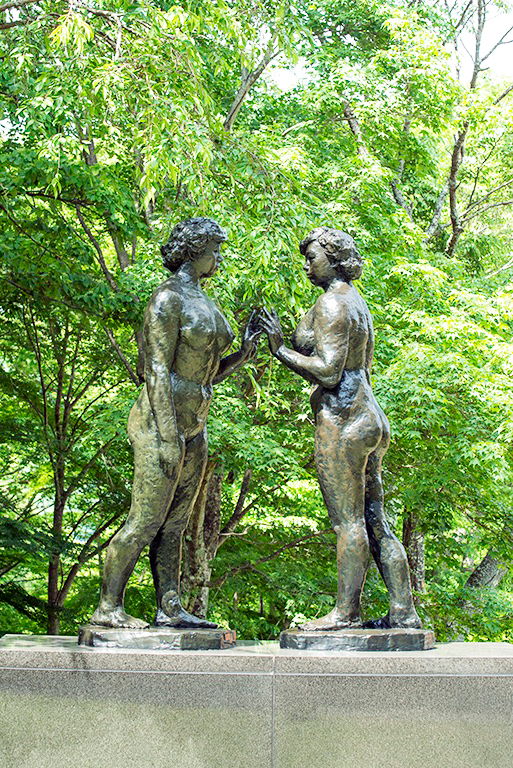Outdoor Sculptures
The outdoor displays are the Hakone Open-Air Museum’s greatest attraction.
Passing through the tunnel at the entrance to the museum grounds, a garden art museum framed by a clear blue sky and the green mountains of Hakone leaps into view as the visitor’s eyes adjust to the sunlight. Sculptures set amid a garden of natural Hakone beauty quietly welcome the visitor to the world of art.
Émile-Antoine Bourdelle (French, 1861-1929)
前へ
次へ
“Force (large version), Victory (large version), Liberty (large version), Eloquence (large version)” 1918-1922
Bronze 375×110×120 cm、375×120×120 cm、375×130×110 cm、375×110×120 cm
“Heracles the Archer (large version)” 1909
Bronze 248×240×90 cm
Force, Victory, Liberty, and Eloquence were created to surround an equestrian monument to the Argentine general Alvear (1788-1852), one of the founders of the modern state of Argentina, celebrating his achievements leading the army during the War of Independence. The equestrian monument was placed on a square column in a plaza in Buenos Aires, with these four statues standing in the four corners. Heracles the Archer depicts the moment when the titular hero of Greek mythology is about to shoot the Stymphalian birds. Émile-Antoine Bourdelle joined Rodin's studio in 1893, where he served as Rodin's assistant (rough sculpting) for approximately 15 years. Bourdelle loved and respected Rodin, but he gradually moved away from Rodin's romanticism and realism, aiming to create a durable, architectural "sculpture as a new reality." He looked for his subjects in mythology while being attracted to the simple, sturdy forms of both archaic Greek sculpture and Romanesque sculpture, fusing both of these styles in his work.
Giuliano Vangi (Italian, 1931-2024)
前へ
次へ
“A Grand Story” 2004
White marble (Carrara) 250×420×330 cm
A group of figures is carved into this piece of marble weighing more than 25 tons. The existence and the meaning of mankind; a life story is sculpted into the stone together with the passing of time. A man from ancient times sits with his arms around his knees inside a cave. In the background appears the face of a woman whom he remembers and, beside her, a young olive tree is depicted covered with leaves. On one side, an entrance to life is open but it becomes narrower further along, representing life's hardships. On the opposite side, oak leaves gently caress the faces of a couple in love, expressing the importance of the coexistence of humans and nature. Further along is a man with his face turned upward; modern man proceeds forward bearing hope, despite meeting hardships in life.
Antony Gormley (British, 1950-)
前へ
次へ
“Close III” 1993
Iron 27×201×174 cm
Antony Gormley first studied archeology and anthropology at Trinity College, Cambridge University, before he studied art. From 1981, Gormley began to produce sculpture using casts made from his own body. The figure in this work lying spread-eagled on the ground is a cast taken of Gormley himself. Usually Gormley makes a plaster cast and after reinforcing it with fiberglass, encloses the entire piece in thin sheets of lead. But this work is cast in iron. The figure is devoid of any facial features and individuality, becoming a universal character.
François-Xavier Lalanne (French, 1927-2008)
Claude Lalanne (French, 1925-2019)
前へ
次へ
“The Weeper” 1986
Trani stone 370×505×470 cm
An angel rests her cheek on the water’s surface, much like the youthful figure of Narcissus from Greek mythology, who falls in love with his own image reflected in the water and is reborn as a daffodil. The object of the angel’s affections remains silent and, as tears run down the side of her face, the reflected image is erased. However, despite the pain of unrequited love, the angel’s face appears somewhere to be smiling. Artist duo and married couple Francois-Xavier and Claude Lalanne co-produced animal-shaped furniture among works in various fields. Themed on animals, insects, and plants, their adorable and mysterious creations invite the viewer into a fantastical world.
Barry Flanagan (British, 1941-2009)
前へ
次へ
“The Boxing Ones” 1985
Bronze 200×168×72 cm
This is a fun work in which two hares appear to be playing around by boxing or dancing on top of a cross. Hares appear in various forms in mythology, literature, and art. The two hares in Barry Flanagan's work have supple limbs full of vitality and, with ears pricked, are standing powerfully on their hind legs like humans. What moral or allegory did Flanagan have in mind for this sculptur of wild hares? He produced conceptual works in the late 1960s through tote 1970s but turned to figurative depictions of animals from the early 1980s.
Arnaldo Pomodoro (Italian, 1926-)
前へ
次へ
“Sphere within a Sphere” 1978-1980
Bronze 250×250×250 cm
Cracks resembling fissures in the ground have penetrated the polished mirror-like surface of the bronze sphere, exposing the interior through the gaps. The tooth-like fractures and seemingly worn-away center contrast with the smooth outer layer, surprising onlookers. Containing a smaller globe, the 1980s larger sphere appears to be nurturing new life, but this too is already in a state of erosion. The hard, inorganic quality of bronze almost ironically accentuates the organic form as if to imply a living organism and the fragility of what it contains.
Martin Matschinsky (German, 1921-2020)
Brigitte Meier-Denninghoff (German, 1923-2011)
前へ
次へ
“Sturm (Storm)” 1980
Stainless steel 400×220×240 cm
Sturm is a German word meaning “storm,” “dash,” “upheaval,” and “rush,” among other things. The work is reminiscent of a large tree whose branches have been completely severed and trunk pushed to its side in a windstorm. The cut ends shine as they catch the light. The trunk consists of a multitude of thin stainless steel rods welded together to form a thick pillar. The narrow grooves between the rods absorb and subtly reflect the light. Extending its branches in dramatic twists even as the trunk tilts in a diagonal curve, the dynamic form gives a sense of the powerful vitality dwelling in huge trees.
Bukichi Inoue (Japanese, 1930-1997)
前へ
次へ
“my sky hole 79 peephole on the sky” 1979
Tempered glass, iron, stainless steel, rubber, concrete 440×760×270 cm
“my sky hole 84 HAKONE” 1984
Stainless steel, weathering steel (COR-TEN), stainless steel wire 1200×600×600 cm
From 1978, Bukichi Inoue began producing works of various shapes and sizes on the theme of "my sky hole." As this suggests, the works incorporated a hole through which the sky could be viewed, forming a place of personal, supreme bliss, and this work was the first to realize the idea. The work depicts the viewer's experience of traveling underground through an iron box before emerging again from a glass box. Sitting on the small, round chair in the small, subterranean room and looking up, a "hole to observe the sky” opens. According to the artist, "it is a place where you can feel the pulse of the earth, a place to talk of the universe.
Masayuki Nagare (Japanese, 1923-2018)
前へ
次へ
“Wind's Impression” 1979
White granite 393×310×137 cm
In 1958, Masayuki Nagare showed a sculpture that combined warehada (cracked texture) stone, which has been roughly split to produce a rough surface texture, with polished stone in a single sculpture. The simple shape, together with the technique of splitting the stone, was highly praised for its deep spirituality first in the United States before Japan. He produced numerous monumental sculptures, both in Japan and the United States, in which he expressed traditional Japanese sensitivity through modern forms. His works make the viewer think of the universe and increase in character the longer they are exposed to the elements.
Susumu Shingu (Japanese, 1937-)
前へ
次へ
“Never-Ending Dialogue” 1978
Iron, aluminum, canvas, paint 779×500×500 cm
“Resonance of Life” 1999
Stainless steel 350×274×274 cm
Two stretched canvas sails change direction according to the wind, moving up and down as if nodding to each other. The airflow and wind resistance of the streamlined shape has been carefully calculated to allow it to capture every possible wind. In even the gentlest of breezes, it will continue to move, slowly and gently, never pausing. This work only comes to life when it merges with the wind, presenting an expression of great vitality. Susumu Shingu said, "It is necessary for humans to develop a sharp, rich sensitivity capable of feeling the rhythms of nature honestly, like plants fluttering in the wind, nurturing a supple strength and capable of adapting to any change." After graduating from Tokyo National University of Fine Arts and Music, he went to Italy, where he studied painting at the Academy of Fine Arts of Rome. He showed his first three-dimensional work in Milan in 1966 and has concentrated ever since on using the flow of wind or water, translating the invisible rhythms of nature into kinetic artworks that never fail to speak to us.
Genichiro Inokuma (Japanese, 1902-1993)
前へ
次へ
“The World of the Sounds” 1979
Glass tile 500×1000 cm
From 1938 to 1940, he studied in France under Matisse. In 1955, he traveled to New York, where he spent the next 20 years and changed his style to abstract painting. After returning to Japan in 1975, he traveled between his studios in Hawaii and Japan, continuing to produce abstract paintings of birds, animals, hands, and faces, all floating in clear, bright colors applied with a distinct rhythm. He believed that art should be available to everybody and produced stained glass and murals to be placed in public spaces. Consisting of powerful, bold colors and shapes, this work is one example of these.
Ryoji Goto (Japanese, 1951-)
前へ
次へ
“Intersecting Space Construction” 1978
FRP, iron, paint 530×943×275 cm
One day, Ryoji Goto happened to notice a wire mesh grid that resembled a repetition of people linked together. This experience gave birth to Diamond Structure (Utsukushi-ga-hara Open-Air Museum), in which he replaced the four-legged carbon atoms that comprise the molecular structure of a diamond with human bodies. It consists of 72 black male figures and 72 red female figures, a total of 144 figures, all stretching their limbs and linking their hands and feet. Combined geometrically in this fashion, emotional relationships disappear, allowing the anonymous people to dance together in praise of their connections and creating a work that is full of youthful energy.
George Rickey (American, 1907-2002)
前へ
次へ
“Two Lines Vertical, Hakone” 1965-1976
Stainless steel 650×50×610 cm
The straight lines of the two triangular columns overlap and then move apart, presenting a different movement each time the wind blows. The arcs they describe are limited to 180 degrees and, although graceful, they are also sharp. George Rickey has produced many works like this one consisting of extremely simple lines, but utilizing different numbers of lines or colors. He has also produced many works with complicated shapes, consisting of numerous parts and resembling chandeliers, or others that comprise flat planes. He made his first experimental mobile in 1945 and began to focus on metal kinetic sculptures from 1950.
Rainer Kriester (German, 1935-2002)
前へ
次へ
“Big Hand” 1973
Aluminum 245×114×39 cm
“White Masked Head” 1981-1982
Limestone (Portugal) 200×105×130 cm
Rainer Kriester studied medicine in what was then East Germany but was imprisoned for defamation of the state and then defected in 1958 to West Berlin, where two years later he entered the Berlin School of Art. Big Hand, which rises up from the ground, seems to represent the artist's earnest desire for life, resulting from his experience of persecution at the hands of the Nazis in the past. For this Heads series, he was inspired by the masks used in Native American worship, the colossal stone heads produced by the Olmec civilization, the carved stone warriors of the Toltec civilization, the Moai of Easter Island, and more. However, Kriester's heads are covered by masks, some have nails driven into them, and still others have their hands over the ears or eyes, as if enduring the unease and fear of the modern world. The open mouth is said to have been inspired by one of Michelangelo's sketches, but what is it shouting?
Taro Okamoto (Japanese, 1911-1996)
前へ
次へ
“Tree Man” 1971
FRP, paint 360×280×310 cm
After relocating to France in 1929, Okamoto gradually moved away from the pure abstract world and discovered surrealism. In 1940, he returned to Japan. After the war, he immediately propounded his principle of “polar opposites,” placing him at the forefront of Japanese avant-garde art theory. In 1970, he created Tower of the Sun (Expo’70 Commemorative Park) for Expo’70 in Osaka. His famous catchphrase, “Art is Explosion,” expressed his personal view of art as being something that rejects communication or understanding, that goes beyond effect and result or historical, cultural and temporal frameworks, constantly expanding without objective. This work, Tree Man, overflows with a dynamic life force, continually proliferating in a free and unrestrained manner.
Akiko Arita (Japanese, 1944-)
前へ
次へ
“Footmarks” 1971
Paint 25×9 cm(200)
What are these footprints? Akiko Arita described her work as follows: "Within the endless flow of time, every event is simply the momentary repetition of life and death, in order to understand this, we can only look to some remaining traces or knowledge that have been passed down to us. This pattern of footmarks expresses the process of people's actions that took place in this space in the past. While these actions should be meaningless to us, the process of awareness, thought, and will that brought about these actions transcends the passage of time and they still dominate the space, exerting a powerful influence over us." We do not know to whose or what manner of life this trace belongs. However, people follow in these footmarks without realizing it and look back over them. That is the power this work has over the viewer.
Kenneth Armitage (British, 1916-2002)
前へ
次へ
“Both Arms” 1969-1970
Bronze 237×207×115 cm
His representation of the human form seen through his unique sense of humor was combined with geometrical shapes. The scale of these body parts−the chest, legs, or arms−were often much larger than life. This work was created after he had spent two years from 1967 in Berlin at the invitation of the German Academic Exchange Service. In 1961, the wall dividing East and West Berlin was built, leading to a period of great political tension. His sympathy and criticism regarding the situation there infuse these two arms that seem to overflow with life and are reminiscent of an ancient Egyptian sculpture.
Takamichi Ito (Japanese, 1939-)
前へ
次へ
“Sixteen Turning Sticks” 1969
Stainless steel, iron, motor, paint 350×300×300 cm
Made of stainless steel and using electricity as its power source, it does not exhibit a stiff, mechanical movement, but rather the swaying lines present a unique, seductive movement. Takamichi Ito graduated in metalwork from Tokyo National University of Fine Arts and Music in 1962. Immediately after graduation, he started working in display design and then later turned to sculpture, becoming active in a wide range of fields including outdoor sculpture, public art, lighting design, and stage design. "In a space where humans exist, there is light," he has said. "In a natural space, there is movement. This light and movement is the theme of my forms." He is recognized as one of Japan's leading kinetic artists.
Marta Pan (Hungarian/French, 1923-2008)
前へ
次へ
“Floating Sculpture 3” 1969
Polyester resin, paint 226×226×113 cm, 183×70×183 cm
This red sculpture, floating on a pond set among lush greenery, does not appear to have been placed in the scenery so much as it has created new scenery. The smaller work glides across the surface of the water when the wind blows, drawing closer to and moving away from the larger one or changing its direction and appearing to enjoy a discourse with the carp that share its pond or with nature itself. If these shapes, with their rich variety, are inspected closely, it can be seen that the shape of the smaller work matches the hole in the larger. She also worked on numerous urban planning and public space projects.
Max Bill (Swiss, 1908-1994)
前へ
次へ
“Pavilion Sculpture” 1969
White granite 252×252×252 cm
Max Bill studied at the Bauhaus and is said to be one of the last of the Bauhaus. His construction principles were based on thorough mathematics. As the word "pavilion" in the name suggests, the viewer is actually able to enter Pavilion Sculpture and the interior was created as part of a series of works aimed at producing a peaceful sculpture. Consisting of 12 granite blocks stacked to create a simple cube, this stable, massive form does not attempt to make some strident appeal, but instead presents a basic, reduced aesthetic form.
Shigeo Matsubara (Japanese, 1944-2012)
前へ
次へ
“Cosmical Color Space” 1968
Iron, paint 200×200×10 cm (12)
Shigeo Matsubara said, "Placing objects in parallel rows links the space, fusing it with the outdoor nature and giving birth to an orderly cosmos." In this work, a series of square objects, all exactly the same size, have been placed in a row and colored red, yellow, green, and blue, following the colors of the rainbow. The 12 colors create a rhythm and harmony, producing a microcosm of color in which it seems we can almost hear sound. This work, is an environmental sculpture, bringing peace to people's minds while surpassing even the form conceived by the artist to assume also the function of play.
Niki de Saint Phalle (French, 1930-2002)
前へ
次へ
“Miss Black Power” 1968
Polyester resin, paint 500×230×75 cm
In order to release her repressed consciousness, she began to create artworks as a form of therapy. This aggressive yet melancholic style changed completely with the appearance of Nana in 1965. This series consisted of gigantic FRP figures of women and the work here is one of them.
Barbara Hepworth (British, 1903-1975)
前へ
次へ
“Two Figures” 1968
Bronze, paint 231×62×33 cm, 244×53×41 cm
Barbara Hepworth said of Two Figures, “This piece expresses two forms related to each other in a kind of tender relationship when one organism is near another.” Comprising abstract forms, this work gives the appearance of two people standing close by. Between the two forms, which are outlined with gentle curves, there exists just the right tension and tender atmosphere. The hole that perforates the upper section extends through to the rear, allowing the figures to blend into the scenery. The holes have been colored, conjuring up an image of an ocean or sky that is much deeper than the actual cavity.
Fernand Léger (French, 1881-1955)
前へ
次へ
“Walking Flower” 1952
Bronze, paint 600×500×200 cm
Unlike other artists who were anxious about the future of humans living in a modern society that was becoming highly functionalized, Léger dreamed of harmony between modern machine civilization and a simple life for humans. In his latter years, he turned his hand to producing monumental compositions combined with architecture. Brimming with vigor, Walking Flower is based on a model Léger made, which was then used to create a work six meters high. Petals form the head, arms, and legs of the work, which appears to being marching proudly toward the sun and lauding the future of a civilization full of energy and power.
Kotaro Takamura (Japanese, 1883-1956)
前へ
次へ
“Michinoku (Northeast of Japan)” 1953
Bronze 220×71×82 cm (2)
Kotaro Takamura is regarded as a pioneer of Japanese modern sculpture, together with More Ogiwara and others. Takamura was a talented poet and critic, and he published articles in magazines about Western modern sculpture inspired by Rodin. He had a strong impact on the fine arts world in Japan at the time. This work is the same as the Statue of Maiden (1953), which stands on the shore of Lake Towada with two identical statues placed facing each other. The artist wrote, "When I caught my reflection in Lake Towada, I felt that something profound could be created by placing two identical statues facing each other." The calm expression of the face on this statue has a likeness to Takamura's wife, Chieko, who had already passed away before this work was created.
Carl Milles (Swedish/American, 1875-1955)
前へ
次へ
“Man and Pegasus” 1949
Bronze 250×336×140 cm
“The Hand of God” 1954
Bronze 380 × 207 × 100 cm
Man and Pegasus depicts the story of the Greek hero Bellerophon, who rode the winged horse Pegasus when he set out to vanquish the monster Chimera. Set atop a soaring pedestal, both man and Pegasus stretch out their bodies to the full, as if aiming to leap even higher. The Hand of God, which is also titled The Universe, is representative of Carl Milles's work in his later years. It has been made to form a silhouette against the sky and, based upon both religion and astronomy, portrays humankind's quest for the truth of the universe. His sculptures incorporate various art styles, including elements of archaic Greek, Gothic, and baroque. Throughout his life, he undertook to examine the existence of humanity from a philosophical viewpoint. In addition, he excelled at employing imaginative compositions to produce uninhibited expressions of movement that are ideally suited to outdoor display, using the sky as a background.
Aristide Maillol (French, 1861-1944)
前へ
次へ
“Action Enchained” 1906
Bronze 213×104×95 cm
Aristide Maillol was originally active as one of the painters of the Nabis movement together with Pierre Bonnard (1867-1947) and Edouard Vuillard(1868-1940) and he did not begin work as a sculptor until the age of 40. His sculptures of women have few sharp protrusions, but rather consist of a series of full, rounded forms. This work was made as a memorial to the socialist Louis Auguste Blanqui (1805-1881), who spent many years in prison. She stands with her hands tied behind her back and her body twisting to one side, creating a sense of dynamic movement that is rare in Maillol’s work. The volume of the voluptuous woman’s body combined with a masculine face overpowers the viewer.
Auguste Rodin (French, 1840-1917)
前へ
次へ
“Monument to Balzac” 1891-1898
Bronze 270x120x127 cm
In 1891, Auguste Rodin was commissioned by the Société des Gens de Lettres to create a memorial statue of the society’s first president, Honor de Balzac (1799-1850). He produced numerous studies based on a portrait by the photographer Nadar (1820-1910). In 1898, Rodin presented a plaster figure of Balzac wearing a gown at the salon but this was criticized variously as resembling a snowman, lava, or a pagan deity, and the Society refused to accept the work, asserting that it was unfinished. Rodin withdrew the work and placed it in his home, where it remained until his death. In 1939, a bronze was finally produced from the work, erected in Paris, and unveiled to the public. The realism of the figure was hidden by the gown, the boldly summarized form leading it to be recognized as the most contemporary of all Rodin’s works.
Gabriel Loire (French, 1904-1996)
前へ
次へ
“Symphonic Sculpture” 1975
Sculptured glass, iron, epoxy resin 1,800 x 800 x 800 cm
With walls consisting of panels, made up of 480 sheets of stained glass, this work creates a unique space, filled with light passing through the colored glass. The title of the work means "a symphony performed by light." Of the various forms of stained glass, the work uses the dalle de verre(slab of glass) technique, employing sheets of glass between two and three centimeters thick. The artist, Gabriel Loire, struck the glass to create patterns of cracks, the light being refracted through these to produce an unparalleled, glittering beauty that he refers to as "sculptured glass." The composition of this work presents the world as it was when Loire was a child, expressing it in the formy. of a prose poem. The st was in divided into four sections facing, respectives, east, south, west, and north, and depicting the four seasons of spring, sum-mer, autumn, and winter, allowing visitors to enjoy the changing seasons as they climb and descend the spiral staircase inside. The roof of the tower statudes a panoramic view of the mountain range of Hakone.










